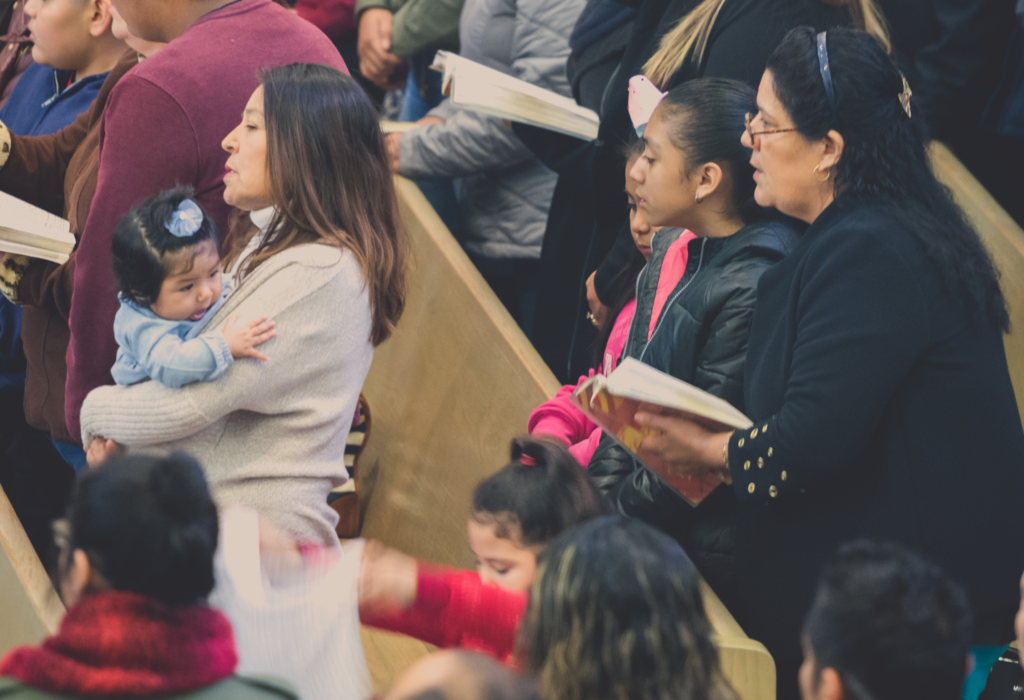Leer el Blog Completo en Español
Nothing defines a community more deeply and clearly than does the repertory of songs that they hold in common. Although congregational singing is, first and foremost, an act of worship, it is also a celebration of community. Congregational singing is the body of Christ on full and conspicuous display, making their voices heard, sounding forth their praise, prayer, and testimony for all to hear. Young and old, rich and poor, the strong and the struggling, the happy and the sad, long-time members and returning visitors, all are drawn to a shared and sung repertoire of hope.
Identity is established in this sharing and singing. The “I” of “my song” and of “your song” becomes the “we” of “our song, our story, our hope.” This is one of the reasons that it is important for the several generations present in a congregation to learn each other’s songs. Each congregation is a family of believers who are on a journey of faith. The songs of our heritage strengthen the songs of our present day and encourage the songs of our young people who are the leaders of tomorrow. Congregational song should not be seen as a time to establish control over our worship. Congregational song is not a contest, nor should it divide us. Congregational song is the story of a community’s shared journey in Christ. The songs of our worship should underscore the natural development and movement of youth becoming adults becoming the elderly. Each stage of life should be present, appropriately engaged in the life of the church, and represented in song, song mutually held and sung.
We don’t learn new songs in order to keep our young people in church, nor to attract the seekers. We learn new songs because each new day brings new blessings. We teach the young people the old songs because each new day is built on the foundation of past blessings. We sing the old and the new in the same worship experience because our worship is to, for, and about God, the God for whom a day is as a thousand years and a thousand years is as a day. We sing the old and the new in the same service because the God we worship exists in the “eternal now,” the eternal day in which there is no night.
Congregational singing is, at the same time, both worship of God and ministry to each other. Every Sunday there will be people present in our churches for whom the week just finished was very difficult and the week that lies ahead has little hope of being better. These people have lived through significant life experiences in the space of a single week. It is all they can do simply to show up at the right place at the right time. There is no song in them. They are present, but they are present without a song. These brothers and sisters need to hear the singing of those of us for whom the week just past and the week that is just ahead are full of joy and promise. The struggling members need to hear the joyful testimony that we can sing as a statement that God is still on the throne, that faith still works, that Jesus is still Lord. As we worship God in song, we are encouraging those around us. We sing to God, for them, until they can again sing for themselves. This is community at work in worship and in ministry.
Congregational singing is an exercise in sharing. We do not always get our way or our wishes. We share time and space with others when we gather as a congregation. Sometimes the songs are our favorites, sometimes the songs are our least favorite. Congregational singing humbles us for the good of the community as that community strives to live the answer to Jesus’ prayer, “Make my followers one.” (John 17:20-21). Singing each other’s songs in worship is an act of obedience, and an opportunity for us to answer Jesus’ prayer for a change. To sing each other’s songs in a community at worship is to give to each other precious gifts, even as we bow before the One who has given us the gift of eternal life.
And then, there is this facet of congregational singing and the strengthening of community: the songs stay with us, even when we are alone. When Sunday morning’s worship has ended, when the congregation has dispersed into their many homes and responsibilities throughout the week, when we have gone back into our little world, the congregational songs go with us. When we remember those hymns and songs and choruses, it is as if the congregation joins us in our solitude. The community is reunited in our hearts and minds through the songs remembered. When we remember those songs held in common, we remember the warmth of the gathering. We remember the hearts and voices of our brothers and sisters in the congregation. We live with the remembered songs and spiritual family throughout the week that now stretches from remembered fellowship to anticipated fellowship. In this way we carry our worship with us in the intervening days. We worship without ceasing. We pray without ceasing. We live in the strength of the community of believers that we call “our congregation” and in the larger community that we call “the Church,” because of the songs that we hold in common. Thanks be to God.
By Terry York
Terry W. York is Associate Dean for Academic Affairs and Professor of Christian Ministry and Church Music at Baylor University’s George W. Truett Theological Seminary. He joined the faculty in 1998 after serving three years as the Associate Pastor of Park Cities Baptist Church in Dallas, Texas. He received the Bachelor of Arts degree from California Baptist University and his Master of Church Music and Doctor of Musical Arts degrees from New Orleans Baptist Theological Seminary.

